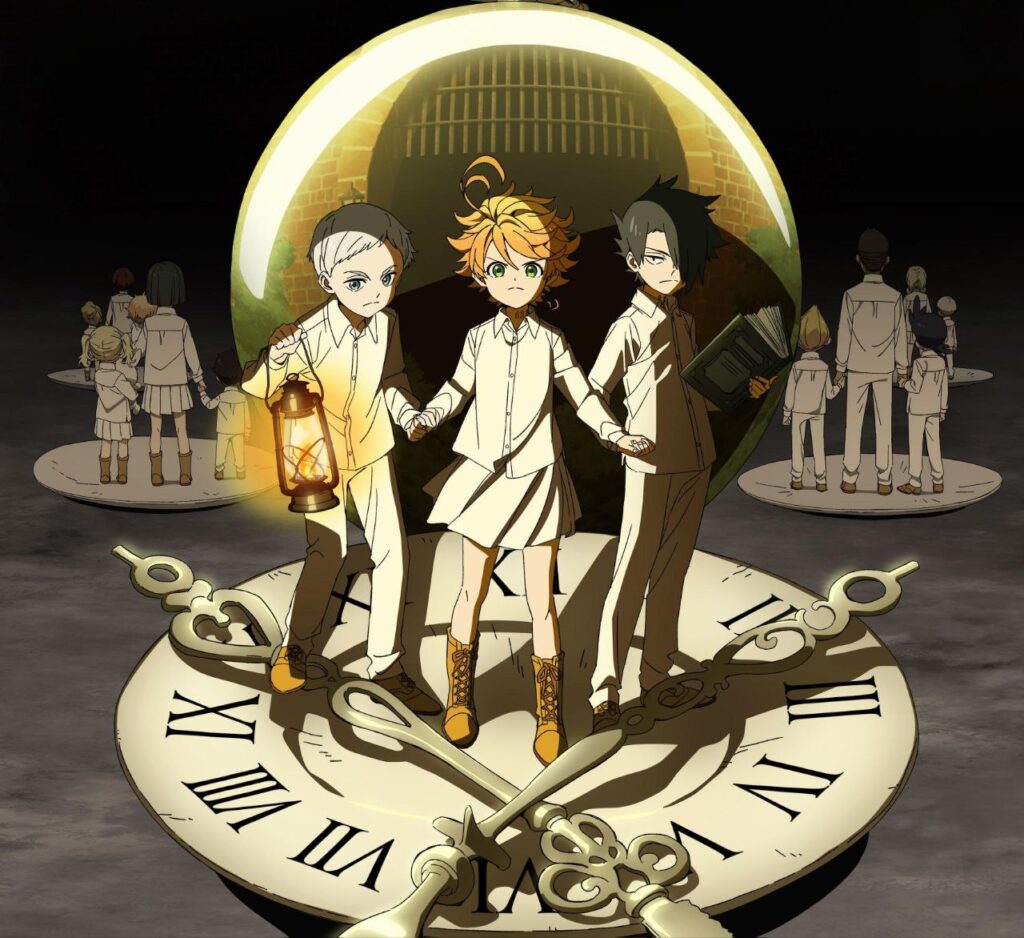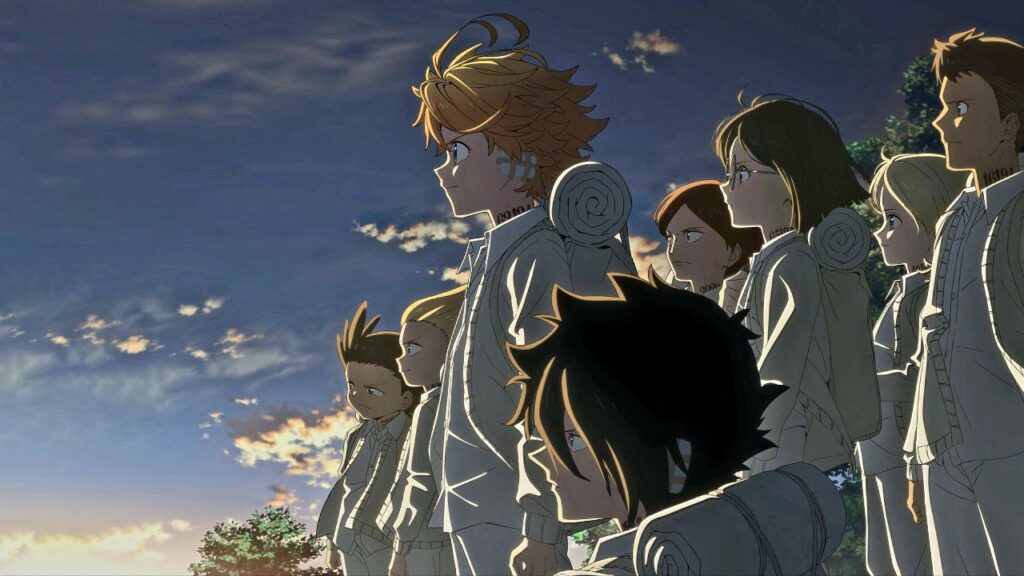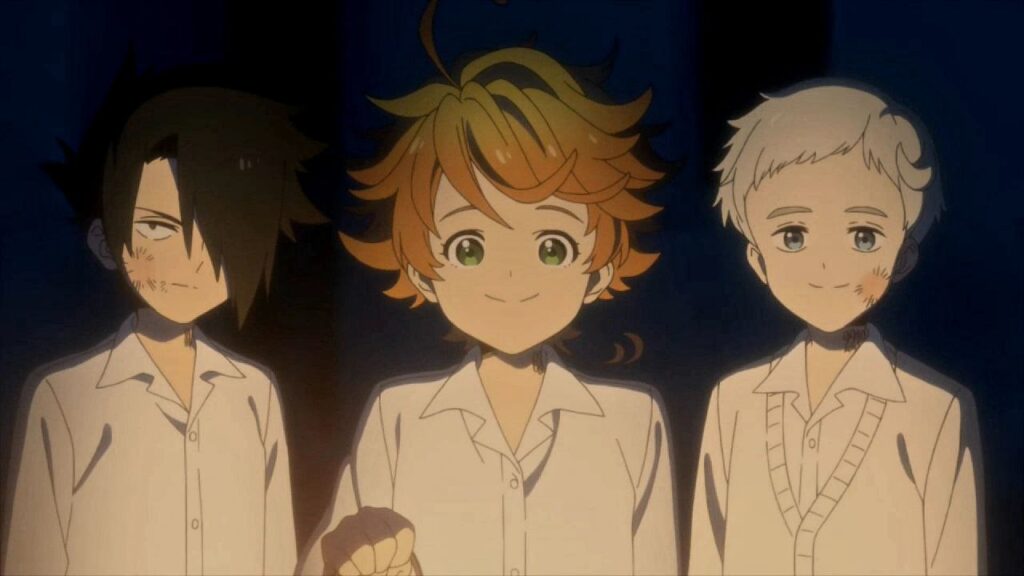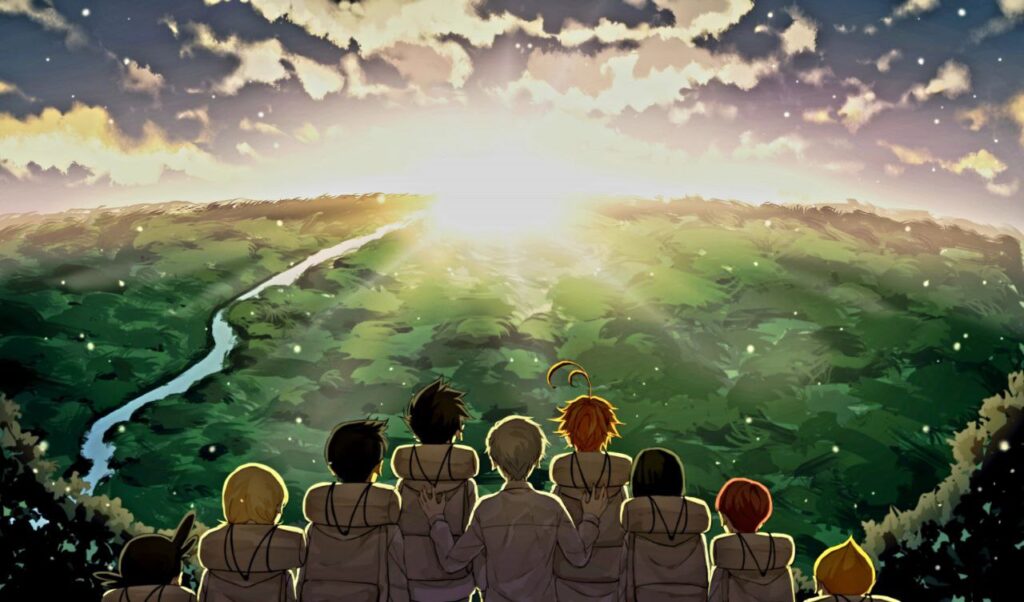
In the realm of anime that captivates both the heart and the mind, “The Promised Neverland” stands out as a shining example of storytelling brilliance. Adapted from the manga series written by Kaiu Shirai and illustrated by Posuka Demizu, this anime has garnered widespread acclaim for its gripping narrative, well-developed characters, and thought-provoking themes. As we delve deeper into the intricacies of “The Promised Neverland,” we uncover a world brimming with suspense, mystery, and existential questions.
Plot Synopsis:
Set in a seemingly idyllic orphanage called Grace Field House, “The Promised Neverland” follows the lives of Emma, Norman, and Ray, three exceptionally bright children who reside there along with other orphans. Under the loving care of their caretaker, Isabella, they lead a peaceful existence filled with studies, games, and communal living. However, their world is turned upside down when they discover the horrifying truth behind their existence.
The orphanage is not what it seems; it is a farm where children are raised as livestock to be harvested and sold to demons. Upon learning this devastating revelation, Emma, Norman, and Ray resolve to escape from their nightmarish fate and lead the other children to freedom. Thus begins a thrilling game of cat and mouse as they outwit their cunning caretaker and navigate a treacherous world filled with danger at every turn.

Themes and Symbolism:
At its core, “The Promised Neverland” grapples with profound themes that resonate with audiences on multiple levels. One of the central themes is the struggle for survival against oppressive systems. The orphanage serves as a microcosm of society, where those in power exploit the vulnerable for their own gain. Through Emma, Norman, and Ray’s defiance and resilience, the anime explores the indomitable human spirit in the face of adversity.
Furthermore, the anime delves into existential questions about the nature of freedom and the pursuit of happiness. The children’s quest for escape represents a longing for autonomy and self-determination, echoing universal desires for liberation from constraints imposed by others. Their journey is fraught with moral dilemmas and ethical complexities, forcing viewers to confront the darker aspects of human nature and the sacrifices one must make in the pursuit of freedom.
Symbolism permeates every aspect of “The Promised Neverland,” adding layers of depth to its narrative. The recurring motif of chess, for instance, serves as a metaphor for the strategic maneuvers employed by both the children and their adversaries. The orphanage itself symbolizes the illusion of safety and security, masking the horrors lurking beneath its façade. Through these symbols, the anime invites viewers to decipher hidden meanings and unravel the intricacies of its story.

Character Development:
Central to the anime’s success is its richly drawn characters, each with their own motivations, fears, and flaws. Emma emerges as the heart and soul of the group, embodying unwavering optimism and compassion in the face of despair. Her determination to protect her fellow orphans drives much of the plot forward, showcasing her growth from a naive child to a formidable leader.
Norman, with his keen intellect and strategic prowess, complements Emma’s idealism with pragmatism and rationality. His calculated approach to problem-solving adds a layer of complexity to the group dynamic, highlighting the importance of intellect and resourcefulness in the fight for survival.
Ray, the third member of the trio, brings a sense of cynicism and skepticism to the group. As the voice of reason, he often challenges Emma and Norman’s idealistic notions, urging them to confront harsh realities and make difficult decisions. His internal struggle between loyalty to his friends and self-preservation adds depth to his character, making him a compelling figure in his own right.
Visuals and Soundtrack:
Visually stunning and atmospherically haunting, “The Promised Neverland” captivates viewers with its meticulous attention to detail and evocative art style. The character designs by Posuka Demizu are distinctive and memorable, capturing the innocence of childhood juxtaposed with the grim reality of their situation. The animation, courtesy of studio CloverWorks, brings the world of the orphanage to life with fluid motion and dynamic camerawork, heightening the tension and suspense of each scene.
Complementing the visuals is a haunting soundtrack composed by Takahiro Obata, which enhances the eerie atmosphere of the anime. From the eerie melodies
that underscore moments of tension to the poignant orchestral pieces that accompany scenes of emotional resonance, the soundtrack enhances the viewing experience, immersing audiences in the world of “The Promised Neverland” and amplifying the impact of its storytelling.

Reception and Impact:
Since its premiere, “The Promised Neverland” has garnered widespread critical acclaim and amassed a dedicated fanbase around the globe. Critics have praised its gripping plot, well-developed characters, and thought-provoking themes, hailing it as a masterpiece of suspense and intrigue. The anime’s ability to keep viewers on the edge of their seats while exploring complex moral and existential questions has solidified its status as a modern classic in the anime pantheon.
Beyond its critical acclaim, “The Promised Neverland” has also made a significant impact on popular culture, inspiring discussions and analysis among fans. Its compelling narrative and rich symbolism have sparked debates about ethics, freedom, and the human condition, prompting viewers to ponder the deeper meaning behind its story. The anime’s success has also led to the production of a live-action film adaptation and a second season, further cementing its legacy in the annals of anime history.
Conclusion:
In conclusion, “The Promised Neverland” stands as a shining example of storytelling brilliance in the world of anime. Through its gripping narrative, well-developed characters, and thought-provoking themes, it captivates audiences and invites them on a journey filled with suspense, mystery, and existential questions. From its haunting visuals to its evocative soundtrack, every aspect of the anime contributes to its immersive experience, leaving a lasting impact on viewers long after the credits roll. As we delve deeper into the intricacies of “The Promised Neverland,” we uncover a masterpiece that challenges our perceptions, ignites our imaginations, and reminds us of the power of storytelling to provoke thought and inspire change.
FAQ:
- What is “The Promised Neverland” about? “The Promised Neverland” is an anime adaptation of a manga series written by Kaiu Shirai and illustrated by Posuka Demizu. It follows the story of Emma, Norman, and Ray, three children living in an orphanage called Grace Field House. However, they soon discover that the orphanage is actually a farm where children are raised as livestock for demons.
- What genre does “The Promised Neverland” fall under? “The Promised Neverland” is primarily categorized as a psychological thriller with elements of mystery, suspense, and dystopian fiction.
- How many seasons of “The Promised Neverland” are there? As of now, there are two seasons of “The Promised Neverland.” The first season aired in 2019, and the second season premiered in 2021.
- Is “The Promised Neverland” suitable for children? While “The Promised Neverland” features child protagonists, it deals with dark and mature themes, including death, manipulation, and existential crises. As such, it may not be suitable for young children and is recommended for older teenagers and adults.
- What makes “The Promised Neverland” stand out from other anime? “The Promised Neverland” stands out for its intricate plot, well-developed characters, and thought-provoking themes. It combines elements of suspense and mystery with deeper philosophical questions about freedom, morality, and the human condition.
- Is “The Promised Neverland” available to watch on streaming platforms? Yes, “The Promised Neverland” is available on various streaming platforms, depending on region and licensing agreements. Platforms such as Crunchyroll, Funimation, and Hulu may offer the anime for streaming.
- Is there a manga version of “The Promised Neverland”? Yes, “The Promised Neverland” originated as a manga series written by Kaiu Shirai and illustrated by Posuka Demizu. The manga was serialized in Weekly Shōnen Jump from 2016 to 2020 and has been compiled into tankōbon volumes.
- Does “The Promised Neverland” have a conclusive ending? Without revealing spoilers, “The Promised Neverland” does have an ending in both the manga and anime. However, opinions on the conclusiveness of the ending may vary among viewers.
- Are there any spin-offs or related works associated with “The Promised Neverland”? While there are no direct spin-offs, “The Promised Neverland” has inspired additional media, including a live-action film adaptation and a mobile game. Additionally, there are side stories and extra chapters included in the manga volumes.
- Is there a possibility of more seasons or additional content for “The Promised Neverland”? As of now, there have been no official announcements regarding additional seasons or spin-offs for “The Promised Neverland.” However, given its popularity, fans remain hopeful for future developments in the franchise.